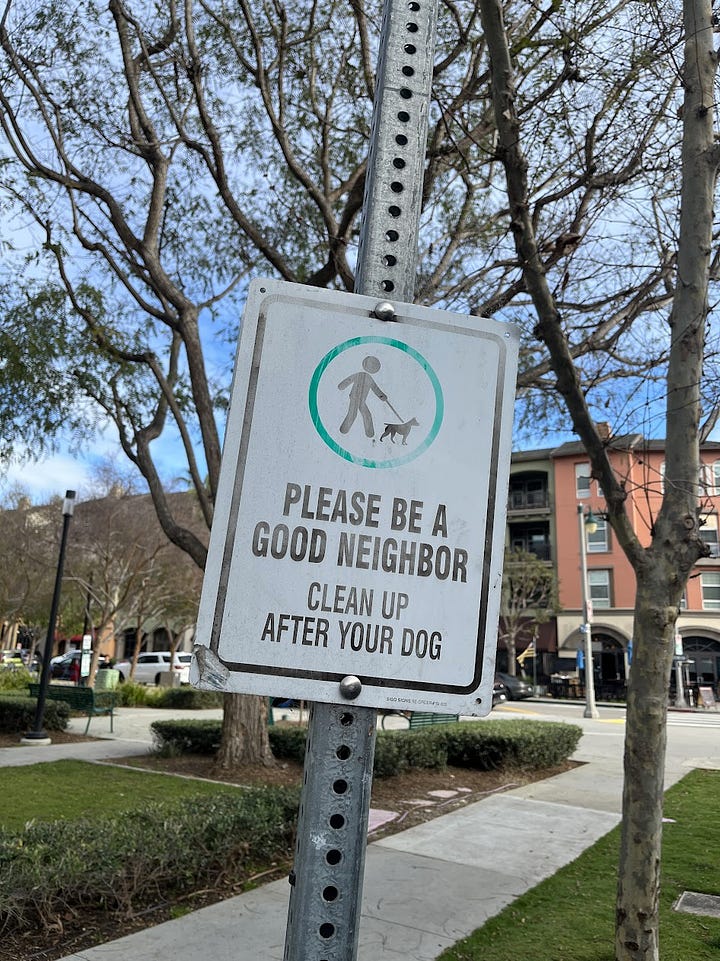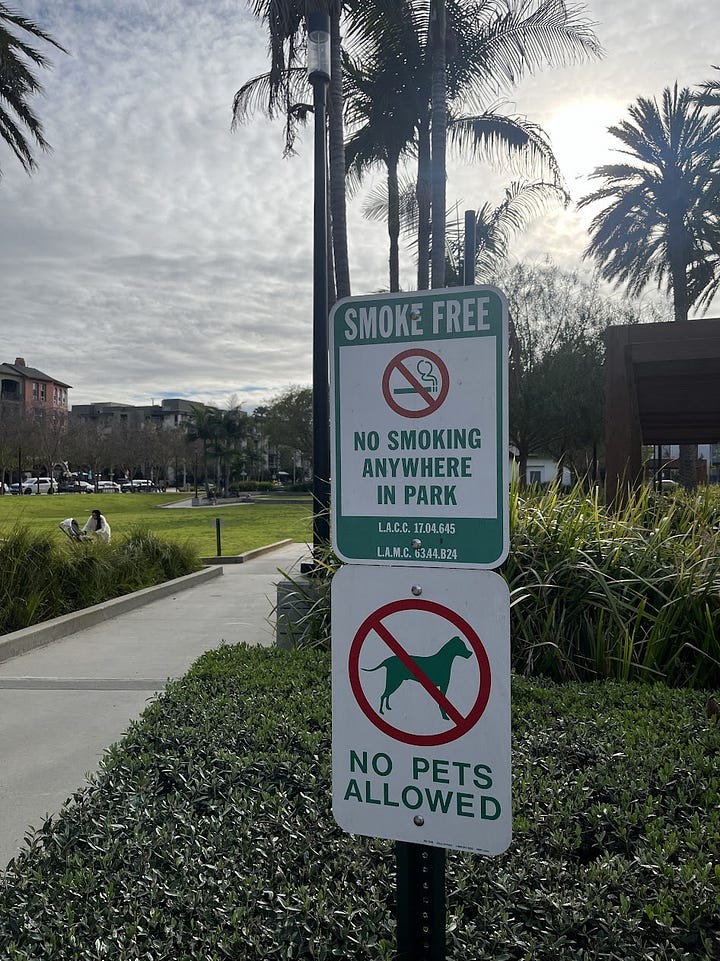Public Space Signage in Helsinki, Fortaleza, and Memphis
A good public sign builds an inclusive identity and is clear, legitimate, and friendly. Oleg Jauhonen from Helsinki´s swimming halls explains how to do it.

Welcome. Thanks so much for subscribing. On this first newsletter on clever policies I write about signs in public space.
My recent move to a new city, Los Angeles, was what led me to thinking about signs. As me and my husband are trying to secure an apartment in this overheated rental market, we settled into temporary housing close to his office for a couple of months. Playa Vista is a new upper middle-class neighborhood with a bit over 20,000 residents, catering to the technology, media and advertising companies in Silicon Beach.
It has become clear on my walks to the grocery store that there is no shortage of guidance on how I should carry myself. There are A LOT of signs. Two have made me pause.
Community Care or Vigilantes?

The first signs are right on our street, stating: ”Warning. Neighborhood Watch. Our neighbors are watching to report any suspicious activity to our local law enforcement agency.”
Neighborhood Watch is a national program where volunteer residents report problems to law enforcement. While the intention behind it is one of community partnerships, I am not alone thinking that these signs do not make me feel particularly safe. Just the presence of signs reminding us of danger is proven to make people overestimate the likelihood of crime and theft. The language of stranger danger is far from the inclusive aspirations described on the organization´s website: “The Neighborhood Watch Program draws upon the compassion of average citizens, asking them to lend their neighbors a hand.“
The sign does not call me to show collective responsibility. Quite the opposite, it alerts me of a (faceless) security operation. Next to the sign´s hostility, it leaves me confused. Who are these neighbors? What is suspicious activity? Who defines it? As Adeoye Johnson writes:
’Thus, “community” at the neighborhood level is often built upon the underlying notion that outsiders and strangers are bad for the neighborhood because they are perceived as the source of crime. “Protecting” the neighborhood’s community then becomes an exclusionary tactic that has an anti-minority, anti-poverty, and anti-”other” dimension.’
Public Space or Private Property?




Halfway to the store I cross Concert Park with lunch tables, benches, tree canopy and a lawn for games. While Concert Park has many characteristics of a public park, I learned quickly that it is actually private property. (It is worth noting that this owner is not identified in any of the signs.)
The park is plastered with signs that send a mix of messages. When does walking or hanging out, normal functions in a park, turn into trespassing or loitering? Leaving this open to discretion is often a coded way to keep unhoused populations or youth out of open spaces.
The confusion on what is allowed extends to our canine companions. The park has a total of 21 signs on dogs alone with five different variations. As a result, there are more questions than answers. Are dogs allowed or not? Or are they not allowed on the grass? Or are they allowed only if they are leashed? Or are they allowed if we clean after them? (As a side note: the attention given to dogs and their bowel movements is understandable as there are estimated to be 5.3 million dogs and 2 million children in Los Angeles County.)
Four Signage Rules
As someone who has spent their career both as a public servant and as a researcher on the conditions for public life, I love a good sign. It has become a habit of mine to take photos of great and problematic signs. Inspired by my “drew it on a napkin” visual analysis above and academic research like that of Jan Svennevig, I suggest four characteristics that could guide public and private organizations to better signage:
1. Identity
What is the identity that the sign activates? Is it inclusive (we all) or exclusive (us vs them)?
2. Clarity
How clear is it what I should or should not do?
3. Legitimacy
What is the organization setting these rules? Is their name or logo visible? What is their legitimacy to set these rules?
4. Friendliness
What is the tone of the sign? Is it friendly, neutral or hostile? Does it expect compliance or misbehavior?
To illustrate these principles in action, here are three signs that get many things right.
Memphis, USA
This sign saying ‘don´t let poop stay where we play’ in Memphis River Parks is clear on what not to do (leave poop) and why (we play here). It has the logo of the organization that is enforcing these rules. It uses playful language to communicate kindness (play and poop). The “we” is open to us all.
Suggestion: The name of the operator would give the sign additional legitimacy.
Fortaleza, Brazil
This sign from the Brazilian State of Ceará makes it clear that there is no room for discrimination. “Notice. The practice of discrimination based on sexual orientation or gender identity is expressly prohibited.” Commercial and public facility operators have a legal requirement to have this sign visible. The sign´s explicit wording and contact details allow users to hold the service provider accountable. The tone is frank but not hostile.
Suggestion: The logo of the state would give the sign additional legitimacy.
Helsinki, Finland
These signs created for one of Helsinki´s most multicultural swimming halls, Itäkeskus Swimming Hall, are straightforward, make the information easily understandable, and explain the justification behind the rules. The logo of the city gives the sign legitimacy. The sign uses polite forms, thanks people for compliance and uses real people in the images for affiliation effect.
Suggestion: Increasing the ethnic diversity, body types and ages of the people on the sign would increase inclusivity.
Oleg Jauhonen: Good signs make it easier to do the right thing
In this newsletter I want to highlight public sector professionals behind the practices. This time, I called Project Coordinator Oleg Jauhonen from the City of Helsinki´s Sports Department. Oleg managed the Itäkeskus swimming hall when the signs were developed and is currently leading the department´s overall signage reform. (He is actually on the sign himself - second from the left.)
What was the need for this sign?
There were three reasons. First, our old signs were outdated and needed an update. Second, just this one swimming hall gets around 320,000 visits a year. Many people, including many immigrants, are visiting a Finnish swimming hall for the first time. We had people attempting to go swimming in their underwear or in full clothing. We wanted to make it easier for people to do things right and provide our staff with better tools to communicate the rules to visitors. And finally, we wanted to lower the threshold for swimming. With these signs, we relaxed our policy on burkinis and swimming shorts. Next to many immigrants, we knew that young boys often felt more comfortable coming in shorts than trunks.
How were these signs created?
Helsinki has a strong service design tradition. The city has pre-approved design firms that the departments can use at a fixed rate. These signs were created in collaboration with our communications team and the design studio Avaava. We also consulted our colleagues from the built environment division, who specialize in accessibility and inclusion. I am amazed every time by their ability to ensure that signs work for as many user groups as possible.
How are they working?
Signs work well when people ask as few questions as possible from staff. These signs have helped out staff to communicate our policies, especially in situations when we do not have a shared language. You can just show how to do things right. As a sign of success, the signs are now used in most swimming halls across the city.
You are currently leading the Sports Department´s work on renewing signs for outdoor recreation areas. What are the lessons you take from swimming halls to that work?
We will be using more illustrations than photography in the new signs. Most importantly, we are testing our sign prototypes first in three sports parks and gathering feedback before investing in new signage for our 30 sports parks. Same goes for signage in our marinas. We do a pilot, see how they work and then develop the final version.
—
That´s it for this month. To conclude: when you see a sign, ask yourself:
Am I inside or outside the community they hope to build?
Do I know what to do?
Do they have the right to set this rule?
Am I am treated with respect?
Thanks for being a subscriber. Any feedback is incredibly welcome. If you enjoyed this, I would love it if you recommend this to your friends and colleagues. The next letter will focus on ways staff can foster neighborly relationships.










Thanks Tommi about interesting and thoughts provoking text!